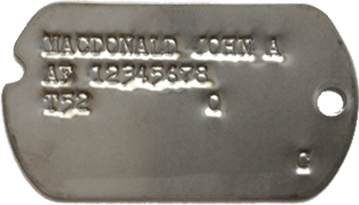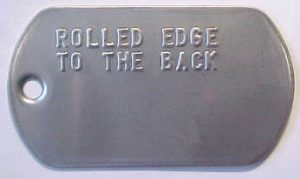Description
$16.99 US Dollars
One set of Dog Tags includes:
2 Indent Stamped, Notched Stainless Steel Tags
1 Stainless Steel 27″ chain, Made in the USA
1 Stainless Steel 5.5″ chain, Made in the USA
2 Black Silencers
Free First-Class US Mail Shipping
Free gift

NOTE:
- Korea Era dog tags were Notched and are only available in Traditional Stainless Steel. The notch is finished with the rolled edge.
- We automatically use Indent text (letters are stamped downward and military standard) on Korea Era dog tags. If you prefer another text option, please note it in the Comments.
- There are no lower case letters. All text stamped with upper case letters (military standard).
- Last name is usually stamped first, followed by a comma, then one space, then the first name, then one space, middle initial, followed by a period. Does vary. Sometimes there is no comma, sometimes there is no period after the middle initial, sometimes both.
- Service numbers are usually 8-digits long beginning with the letters AF. The numbers can have spaces in between the numbers or not (see picture above called Alternate Air Force Format for 1950-1956).
- The year the tetanus shot was given to the soldier is listed after a “T”. It is usually the same year the soldier enters military service. Usually, it is shown as TXX (no space after the T) but can be T XX (one space after the T) or T-XX (a dash after the T).
- The choices for blood type during the Korea Era are: A, B, AB or O . As soon as 1951, the Rh factor of POS or NEG was included by the Air Force.
- The choices for religious preference were designated by the single letter C, P, or H. C (Catholic), P (Protestant) and H (Jewish). Those were the only choices. The inclusion of different religious choices and the writing of the complete word does not appear until 1956.
- Don’t worry about having the exact format. The data presented here was taken from actual dog tags that we have seen. As long as you have the above stated information, your dog tags will be extremely close. Also, the years stated are general guidelines. Your actual unit’s dog tags may vary earlier or later.




















 Rolled Edge to Front (the rolled edge can be seen when reading the text) is how we usually stamp Current Issue dog tags.
Rolled Edge to Front (the rolled edge can be seen when reading the text) is how we usually stamp Current Issue dog tags.
 WWII and Korea era dog tags were stamped with the rolled edge to the back (the rolled edge can not be seen when reading the text).
WWII and Korea era dog tags were stamped with the rolled edge to the back (the rolled edge can not be seen when reading the text).